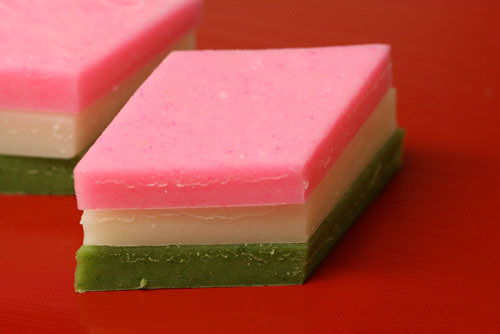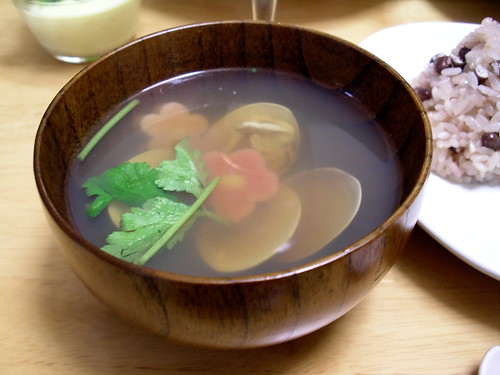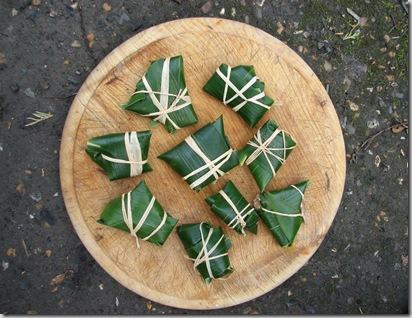
Remember this character? We introduced it too early back then in Hiragana Lesson 7: ‘き’ [ki]. It was when we were talking how some characters may be combined with yo-on. This is the original character. Y section has only up to 3 characters (a, u, o) compared to other groups who have 5 type of characters that ends in: a, i, u, e, o.
Just to inform you in case you think we are skipping some characters.
Pronunciation:
‘や’ is romanized ‘ya’, pronounced ‘ya’ as in ‘yard’.
Words with ‘や’:
‘や’ at the beginning:
- 休む/やすむ (yasumu -> to rest; to have a break; to take a day off, etc)
- やる (yaru -> to do [something] (more casual than suru))
- 安い/やすい (yasui -> cheap; inexpensive; peaceful; quiet)
- 野菜/やさい (yasai -> vegetable)
- 約束/やくそく (yakusoku -> promise; arrangement)
- 山/やま (yama -> moutain)
- 優しい/やさしい (yasashii -> kind; gentle)
- 野郎/やろう (yarou -> rascal [I am sure you hear this in anime a lot! xD])
‘や’ in the middle:
- おやすみ (oyasumi -> good night [phrase])
- 速い/はやい (hayai -> quick; fast; swift)
- 早い/はやい (hayai -> early)
- 老爺/おやじ (oyaji -> one's father [slang]; old man; one's boss)
‘や’ at the end:
- 蚊屋/かや (kaya -> mosquito net)
- 部屋/へや (heya -> room)
Stroke order:


Task: You shall write ‘や’ 50 - 100 times in your textbook. Memorize the shape, the stroke order, the sound, the pronunciation (echo the sound of the character each time you write it down), etc.
Japanese Nationwide Festivals
Yamato: Yo, omaetachi (guys)! Ore wa Yamato da, not my real name though because of my job as an ANBU Black Ops!
Yamato: Maybe some of you been wondering why I'm not wearing my mask... well, well, due to any circumstances, I put off my mask. I was in charged of being a captain of Team 7 since Kakashi-senpai was badly injured while ago... but, it wasn't such an easy task accompanying the reckless Naruto-
Naruto: Oy, oy, nani ga itta (what did you say), Yamato-taichou?
Yamato: Naruto? Kiichatta omae (did you hear)?
Naruto: Kikoeru koto ga dekinetee darou? (How could I not hear?)
Yamato: Yahaha~ suman, suman... tonikaku, nande omae koko ni? (sorry, sorry... by the way, why are you here?)
Naruto: Huh, I heard you are about to teach about Nihon no matsuri (Japanese festival), didn't ya? Why not asking me to join, Taichou? Kono Naruto Uzumaki, zettai joozu ninja da (This Naruto Uzumaki is an absolutely smart ninja)!
Yamato: Joozu ka yo (smart)? I thought you were in the dead-last...
Naruto: Yappa Yamato-taichou ussee neetebayo...
Yamato: Joodan, joodan datta... Maa, how about we begin the class now, everyone? As Naruto said, we're going to know closer about Nihon no matsuri generally...
Naruto: Hayaku oshiete kure...
Yamato: Gaman kudasai na (Be patient) ... Naruto, omae mokuhi suru, ore wa karera o oshiete kureru yo... (Naruto, you keep silent while I'm teaching them, okay?)
Naruto: Mokuhi (keep silent)? Shitakuneetebayo (I won't)!
Yamato: Taku... maa, shou ga nai naa (Geez, it can't be helped)...Well, Naruto, you can help me answer questions from that Kaoko-san and Tna-san. Wakatta yo (understand)?
Naruto: Haaai~ makasete zo! (Yes, leave that to me!)
Yamato: Maa, hajimemashou (let's begin)! Japanese festivals or in Japanese Nihon no matsuri, are traditional festive occasions. There are three types of Nihon no matsuri, which are local festivals, Handaka Matsuri, and nationwide festivals. But we're now going to know closer about Japanese nationwide festivals, including New Year, Doll Festival, Hanami, Children's Day, Tanabata, Bon Festival, Lantern Floathing, and 7-5-3 Festival...
Tna: Well, all country around the world surely celebrate a new year festival, but how Japanese people celebrate it?
Yamato: Maa, that's what we're going to learn now. New year (Shogatsu) is celebrated on January 1-3, annually.
Yamato: Before the new year, homes are cleaned, debts are paid off, and osechi (food in lacquered trays for the New Year) is prepared or bought. The new year's eve itself is called Oomisoka.
Tna: Osechi? What kind of food that was?
Naruto: I'll answer! Osechi foods are traditional foods which are chosen for their lucky colors, shapes, or lucky-sounding names in hopes of obtaining good luck in various areas of life during the new year. Osechiconsists of boiled seaweed (昆布 konbu), fish cakes (蒲鉾 kamaboko), mashed sweet potato with chestnut (栗きんとん kurikinton), simmered burdock root (金平牛蒡 kinpira gobo), and sweetened black soybeans (黒豆 kuromame)...
Osechi
Kaoko: Umai~ (delicious~) then what Japanese people usually do during the shougatsu (new year)?
Yamato: We usually visit Buddhist temples and Shinto shrines. On January 1st, Emperor in Imperial Palace performs the rite of shihoohai (worship of the four quarters) at dawn. On the 2nd adn 3rd day, acquaintances visit one another to extend greetings (nenshi) and sip otoso (a spiced rice wine). Some games played at New Year's are karuta (a card game), hanetsuki (similar to badminton), tako age (kiteflying), and komamawashi (spinning tops). These games are played to bring more luck of the year...
Karuta
Hanetsuki
Tako Age
Komawashite (Spinning Top)
Naruto: Ah chotto, chotto, Yamato-taichou... wasureteta (did you forget)? We also exchange postcard which the post office guarantee it will come on the first of January. Sore wa... what we are waiting for is otoshidama!
Yamato: Not 'we', Naruto. Actually, only children who receive otoshidama (money in small decorated envelopes)...
Otoshidama
Tna: Wah, that must be nice! But I think I don't deserve it since I'm not a kid anymore...
Naruto: Nah, that way, you're supposed to give us, Tna-senpai~
Tna: No fair~! *sigh*
Yamato: Maa, tsuzukemashou (Well, let's continue). The next matsuri is Doll Festival or in Japanese is Hinamatsuri or Girl's Day. It's held on March 3. Platforms covered with a red carpet are used to display a set of ornamental dolls (雛人形 hina-ningyō) representing the Emperor, Empress, attendants, and musicians in traditional court dress of the Heian period...
Hina-ningyo (Ornamental Dolls)
Yamato: Formerly, people believed the dolls possessed the power to contain bad spirits, in which straw hina dolls are set afloat on a boat and sent down a river to the sea between Takano and Kamo rivers, supposedly taking troubles or bad spirits with them. But now they have stopped it because of fishermen catching dolls in their nets...
Kaoko: Sokka... then what the customary food or beverage during the Hinamatsuri?
Yamato: It's shirozake, a sake made from fermented rice. A colored hina-arare, bite-sized crackers flavored with sugar or soy sauce depending on the region, and hishimochi, a diamond-shaped colored rice cake, are served. Chirashizushi (sushi rice flavored with sugar, vinegar, topped with raw fish and a variety of ingredients) is often eaten. A salt-based soup called Shiojiri containing clams still in the shell is also served.
Shirozake
Hishimochi
Chirashizushi
Shiojiri
Tna: The chirazushii and shiojiri look delicious that make me hungry... then, back to the doll. How about the placement orders of the doll?
Naruto: Shounen kara, wakaraneetebayo~ kedo, Sakura-chan ga shiru kamo shirenai (I'm a boy so I don't know that thing, but Sakura-chan maybe knows)... But, but, she's not kind of girlish- itee (hurts)~!
Sakura: Nani ga itta (what did you say), NARUTO!
Naruto: Iya iya iyaaaaa! Jitsu wa... ano... Sakura-chan... Tna-senpai to Kaoko-senpai would like to know about the placement order of hina-ningyo... Sakura-chan ga shitte darou?
Sakura: Ah, mochiron (of course)! Actually the Kantō region and Kansai region have different placement orders of the dolls from left to right, but the order of dolls per level are the same. The first platform (the top) tier holds two dolls, which are known as Emperor holding a ritual baton and Empress holding a fan. Optionals are the two lampstands, called bonbori....
Hina-ningyo's First Top
Sakura: The second tier holds three court ladies san-nin kanjo (三人官女). Each holds sake equipment. From the viewer's perspective, the standing lady on the right is the long-handled sake-bearer Nagae no chōshi (長柄の銚子), the standing lady on the left is the backup sake-bearerKuwae no chōshi (加えの銚子), and the only lady in the middle is the seated sake bearer Sanpō (三方)...
Second Platform
Sakura: The third tier hold five male musicians (gonin bayashi). Left to right (from the viewer's perspective) is small drum (Taiko), seated; large drum (Ootsuzumi), standing; hand drum (Kotsuzumi), standing; flute (Fue), seated; and singer (Utaikata), holding a folding fan and seated. The fourth tier holds two ministers (daijin), while minister on the right is depicted as a young person, while the other one is much older.
Sakura: The fifth tier, between the plants, holds three helpers or samurai as the protectors of Emperor and Empress. The other two platforms (the sixth and seventh), tier a variety of miniature furniture, tools, carriages, etc. Sore wa ijou~
Tna: Arigatou, Sakura-chan! That's really helpful information...
Sakura: My pleasure~ If you don't mind, I'm excused now to train. Shitsureishimasu~
Naruto: Matte matte Sakura-chan... Ikanee de... (Wait, Sakura-chan, don't go...)
Yamato: No use, Naruto. Sakura has left already. Well, we'll continue to Hanami or Cherry Blossom Festival!
Yamato: Hanami is the Japanese traditional custom of enjoying the beauty of flowers from the end of March to early May, sakura bloom all over Japan, and around the first of February on the island of Okinawa. Hanami at night is called yozakura. Sakura originally was used to divine that year's harvest as well as announce the rice-planting season. People believed in kami inside the trees and made offerings. Afterwards, they partook of the offering with sake...
Naruto: The hanami celebrations usually involve eating and drinking, and playing and listening music. Some special dishes are prepared and eaten at the occasion, like dango and bento, and it's common for sake to be drunk as part of the festivity. Maybe you've heard about proverb "Hana yori dango (Dumplings rather than flowers)"? Nah, that's actually to make fun of people who prefer to eat and drink instead of admiring the blossom...
Bento
Dango
Tna: Ooh, we knew that! I like the drama!
Kaoko: You like it, Tna-chan? Me too!
Naruto: Sasuga onna no da... Ja, tsuzukeruyo (let's continue), Yamato-taichou...
Yamato: Next is Children's Day or Kodomo no Hi (previously called Tango no Sekku). It's a Japanese national holiday which takes place annually on May 5, the fifth day of the fifth month. Kodomo no Hi is a day set aside to respect children's personalities and to celebrate their happiness...
Yamato: Before this day, families raise koinobori flags, which are carp-shaped wind socks. They are made by drawing carp patterns on paper, cloth or other non-woven fabric. They are then allowed to flutter in the wind...
Naruto: Those carp sets are flown above the roofs of houses with sons, with the biggest (black) koinobori for the father, next biggest (red) for the mother, and ranging down to the smallest carp for the youngest son.
Tna: Sokka... then any specific food that you usually eat in Kodomo no Hi?
Naruto: Of course! We usually eat chimaki (rice cakes wrapped in cogan grass or bamboo leaves) and kashiwamochi (rice cakes filled with bean paste and wrapped in oak leaves)...
Chimaki
Kashiwamochi
Yamato: Okay, the next is Tanabata. Have you ever heard?
Tna: Yeah! Is the festival held in July 7th?
Yamato: Seikai! Tanabata is a Japanese star festival, originating from the Chinese Qixi Festival. It celebrates the meeting of Orihime (Vega) and Hikoboshi (Altair). According to legend, the Milky Way, a river of stars that crosses the sky, separates these lovers, and they are allowed to meet only once a year on the seventh day of the seventh lunar month of the lunisolar calendar. The celebration is held at night...
Naruto: I know the traditional song of Tanabata...
Sasa no ha sara-sara (笹の葉 さらさら)Nokiba ni yureru (軒端にゆれる)Ohoshi-sama kira-kira (お星様 キラキラ)Kingin sunago (金銀砂子)
Translation:
The bamboo leaves rustle,shaking away in the eaves.The stars twinkle;Gold and silver grains of sand
Yamato: In present-day Japan, people generally celebrate this day by writing wishes, sometimes in the form of poetry, on tanzaku (短冊 tanzaku), small pieces of paper, and hanging them on banboo, sometimes with other decorations...
Kaoko: What kind of wish did you usually write, Naruto-kun?
Naruto: Eto- himitsu da yo, himitsu! (It's a secret, a secret!)
Tna: Maybe Naruto wished that he could be together with Sakura-chan someday, ne?
Naruto: Sssh... keep it a secret between us, okay?
Kaoko: The four of us? I can't guarantee~ Haha~
Naruto: Temee~!
Yamato: Naruto, yamero! (stop it!) Ok, we'll continue. The next is Bon Festival held on August 13th - 15th. It's a Japanese Buddhist custom to honor the departed (deceased) spirits of one's ancestors...
Tna: Then, what is Bon Odori? I've heard that somewhere...
Yamato: Bon Odori, meaning simply Bon dance is a style of dancing performed during Obon. Originally a Nenbutsu folk dance to welcome the spirit of the dead, the style of celebration varies in many aspects from region to region...
Naruto: Just so you know, after Bon Festival ends, there is Lantern Floating, held on August 15th and 16th. Small paper lanterns containing lighted candles are floated on rivers or the sea light the way for the ancestral spirits as they depart. Usually a message is written on the outside of the paper lantern...
Yamato: Yappari (finally) it's the last one called 7-5-3 Festivals or Shichigosan. It's a traditional rite of passage and festival day in Japan for three- and seven-year-old girls and three- and five-year-old boys, held annually on November 15...
Yamato: The ages three, five and seven are consistent with Japanese numerology, which dictates that odd numbers are lucky. Children are taken to the local shrine to pray for their safe and healthy future. This festival started because of the belief that children of certain ages were especially prone to bad luck and hence in need of divine protection. They are usually dressed in traditional clothing for the occasion and after visiting the shrine many people buy chitose-ame ("thousand-year candy") sold at the shrine...
Naruto: Chitose no Ame symbolizes healthy growth and longevity... Well those all about Japanese Nationwide matsuri. Any question?
Tna: *shakes head* No, it's pretty clear as for the introduction. Well, thank you very much, Yamato-san and Naruto-kun~
Kaoko: We will never forget this important lesson. Ja, see ya~
Naruto: Ano... you should not forget to... treat me ramen...
Tna: Oh, wasurechatta (I'm forget))~ kore douzo (this, please), Naruto-kun...
Naruto: Waaah~ Sankyuuu~! Itadakimasu! (Thank you! Let's eat!)... oishii dattebayooo~! (It's delicious!)
Story written by Tna~ <3

































No comments:
Post a Comment